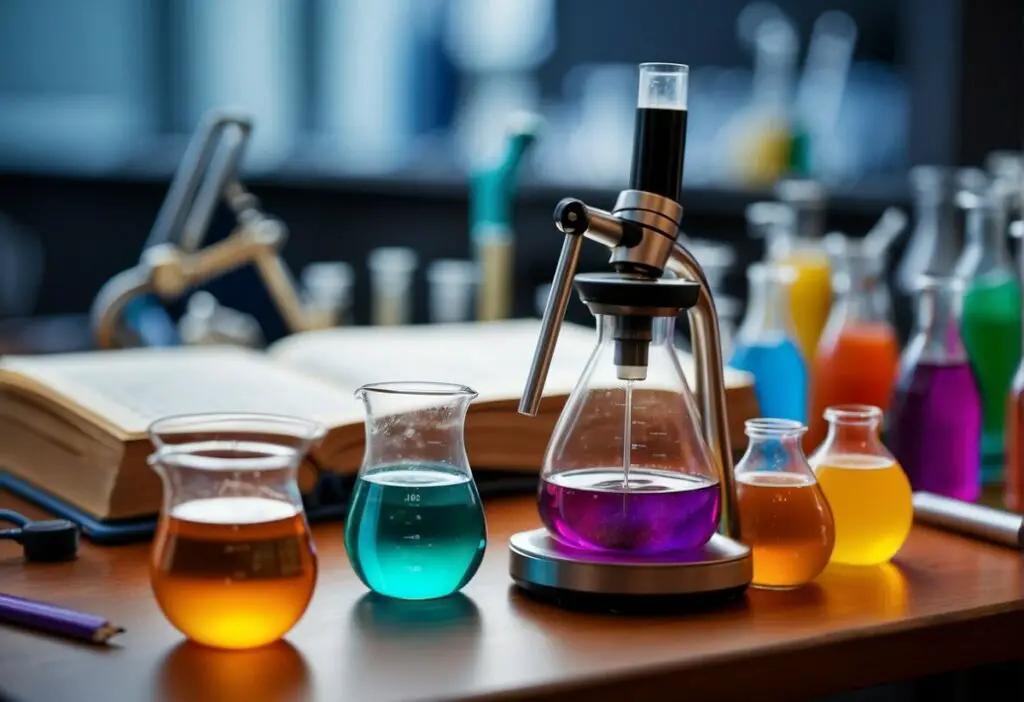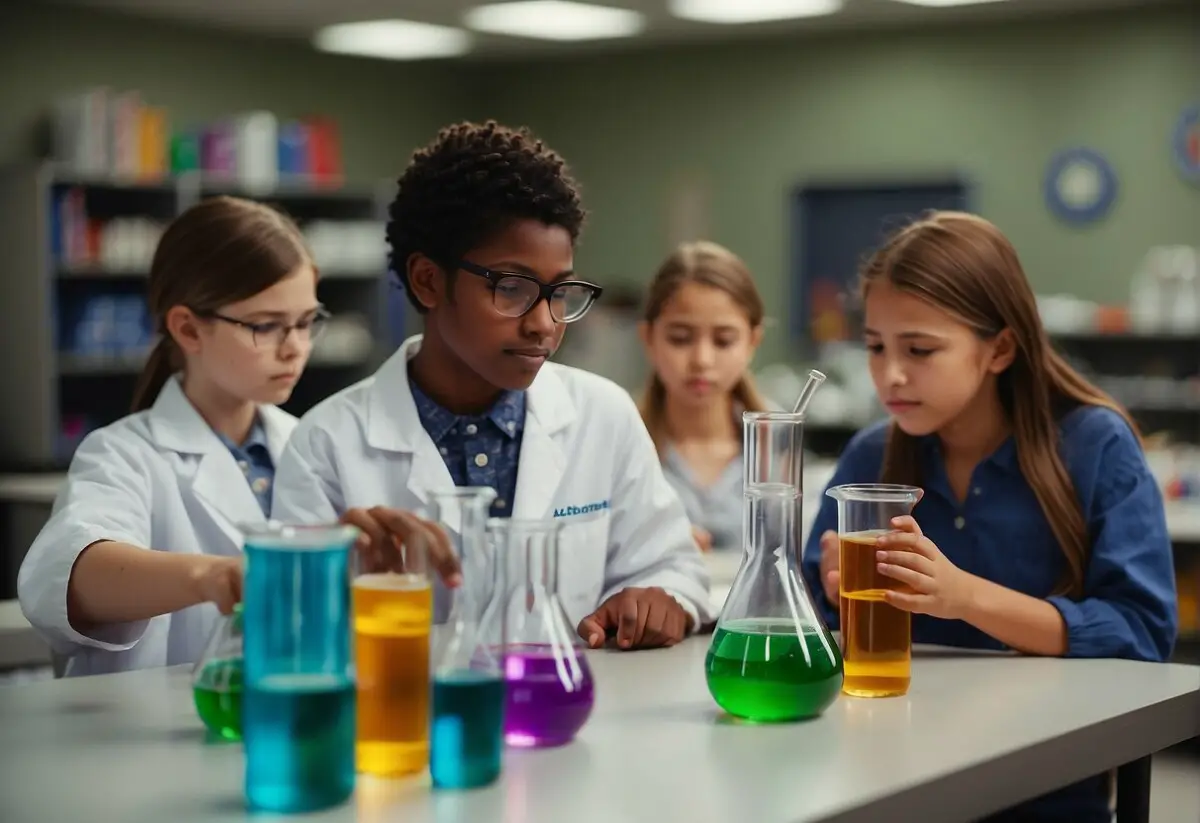Engaging middle schoolers in science often means finding ways to spark their curiosity and wonder about the natural world.
We know that at this stage, students are ready to explore more complex concepts, yet they need experiments that are compelling enough to hold their attention.
That’s where well-designed science projects come in – they bridge the gap between textbook theory and real-world application, allowing students to see the relevance of what they’re learning.

Our challenge is to present science in a way that is not just informative but also hands-on and fun.
We aim to create experiences that balance educational content with interactive elements.
This approach not only solidifies students’ understanding of scientific principles but also fosters a deeper appreciation for the subject.
By involving them in experiments that are as entertaining as they are educational, we prepare them for a lifetime of inquisitive thinking and problem-solving.
We carefully select activities that can easily be conducted in a classroom or at home with readily available materials.
Experiments like the flying tea bag and the egg float project demonstrate basic principles of physics and chemistry in an engaging way.
These experiments encourage students to ask questions, form hypotheses, and conduct trials, laying the groundwork for more advanced scientific study in the future.
Fundamentals of Science Experimentation

Before diving into specific experiments, we need to comprehend the bedrock of any scientific inquiry: the scientific method and lab safety protocols.
Scientific Method Principles
The scientific method is the backbone of all scientific inquiry; it’s the structured approach we use to investigate questions and test hypotheses in a repeatable way.
- Ask a Question: Everything starts with our curiosity, leading us to ask a question about the world around us.
- Do Background Research: Informed experimentation comes from knowing what others have already discovered.
- Construct a Hypothesis: We develop a testable prediction based on our research.
- Test with an Experiment: The core of the scientific method—where we see if our hypothesis holds up.
- Analyze Results and Draw Conclusions: After conducting the experiment, we look at what the data tells us.
- Report Results: Sharing what we’ve learned helps build the body of scientific knowledge.
Through this iterative process, we refine our understanding and advance science.
Safety Protocols in the Laboratory
Safety in the laboratory is non-negotiable. We follow stringent safety protocols to protect ourselves and our classmates.
- Wear Personal Protective Equipment (PPE): This typically includes goggles, lab coats, and gloves to prevent injuries.
- Understand the Equipment: Before we use any lab tools, we make sure we’re trained on how to use them correctly and safely.
- Know the Chemicals: Understanding the properties of the chemicals we’re handling, including potential hazards, is vital.
- Follow Instructions Precisely: We adhere strictly to written procedure to ensure experiments are conducted safely.
By maintaining a culture of safety, we ensure that our scientific exploration promotes learning without compromising on well-being.
Interactive Physics Experiments
Middle schoolers can gain a deeper understanding of physical principles through hands-on activities. Our focus here is to engage students with interactive experiments that elucidate the concepts of mechanics and electromagnetism.
Exploring Newton’s Laws
Demonstrating Inertia: We can illustrate Newton’s first law by using a Newton’s Cradle, showcasing how a stationary object will remain at rest and a moving object will stay in motion at constant velocity, unless acted upon by an unbalanced force.
- Purpose: To observe momentum transfer and the conservation of energy.
- Materials: Steel balls, string, and a frame.
- Procedure: Lift and release one ball to strike the rest and watch the reaction.
Exploring Force and Mass: In our experiment involving a modified Atwood machine, students learn that force is equal to mass times acceleration (Newton’s second law).
- Purpose: Understanding the relation between acceleration, force, and mass.
- Materials: String, two masses, and a pulley system.
- Procedure: Compare acceleration with different mass configurations.
Electricity and Magnetism Fundamentals
Building Simple Circuits: We can engage students with the basics of electricity by constructing a circuit that lights a bulb using a battery, wires, and a switch.
- Purpose: To learn about electrical flow and circuit components.
- Materials: Battery, wires, light bulb, and switch.
- Procedure: Connect the components to create a closed circuit that lights the bulb when the switch is activated.
Exploring Electromagnetism: Crafting an electromagnet demonstrates the interplay between electricity and magnetism, a cornerstone of physics.
- Purpose: To show how electric current can produce a magnetic field.
- Materials: A nail, wire, battery, and iron filings.
- Procedure: Wrap the wire around the nail, connect it to the battery, and observe the attraction of iron filings.
Chemistry in Action

Engaging with chemistry allows us to explore the tangible effects of invisible forces at work. Through hands-on experiments, we can transform abstract concepts into memorable learning experiences.
Chemical Reactions and Equations
In our exploration, we often start with the foundations of chemical reactions and equations.
For instance, teaching the principle of conservation of mass is more impactful when students can witness the process in real-time.
A classic demonstration involves mixing baking soda and vinegar, which creates a visible eruption of bubbles—the iconic result of a gas-producing reaction.
Not only do we observe the chemical change, but we also illustrate how to write and balance chemical equations that represent these reactions, ensuring our understanding is both practical and theoretical.
Acids, Bases, and pH Explorations
Delving into acids, bases, and pH explorations, a captivating hands-on activity is the use of red cabbage juice as a pH indicator.
By adding different household liquids like lemon juice or baking soda solution to the cabbage juice, the solution changes color based on the pH level.
These shifts in color allow us to classify substances as acidic or basic.
Students not only learn about pH levels but also about the importance of acids and bases in our everyday lives.
Through experimental observations, we reinforce the concept that acids and bases interact to form water and salt in a neutralization reaction.
Biological Discoveries
In exploring the realm of biology, we focus on two foundational concepts: the microscopic world of cells and the essentials of plant life.
Our hands-on experiments are designed to reveal these intricate biological processes in a comprehensible manner.
Cell Biology and Microscopy
Through Cell Biology and Microscopy, we dive into the fundamental units of life: cells.
Utilizing microscopes, students can examine the structure of plant and animal cells, compare their differences, and understand cell function.
For instance, in a Pond organisms microscope lab, middle schoolers can collect samples from local water bodies to observe the diverse microorganisms that play vital roles in ecosystems.
- Objective: To identify cellular structures and understand their functions.
- Materials: Microscopes, prepared slides, pond water samples.
- Activity Steps:
- Observe prepared slides of plant and animal cells.
- Collect pond water samples.
- Examine the microorganisms under a microscope.
- Record and discuss findings.
Plant Growth and Photosynthesis
In the Plant Growth and Photosynthesis section, we turn our attention to how plants sustain themselves and grow.
By conducting experiments like measuring the rate of photosynthesis or observing germination, students can grasp the significance of light, water, and carbon dioxide in the lifecycle of plants.
- Objective: To explore the process of photosynthesis and factors affecting plant growth.
- Materials: Bean seeds, soil, water, light sources, carbon dioxide sensors.
- Activity Steps:
- Plant bean seeds and monitor germination.
- Investigate the effect of light intensity on the rate of photosynthesis.
- Use carbon dioxide sensors to measure photosynthetic rates.
- Analyze and interpret the results.
These biological discoveries help middle schoolers enhance their understanding of the natural world and its complex interactions!


